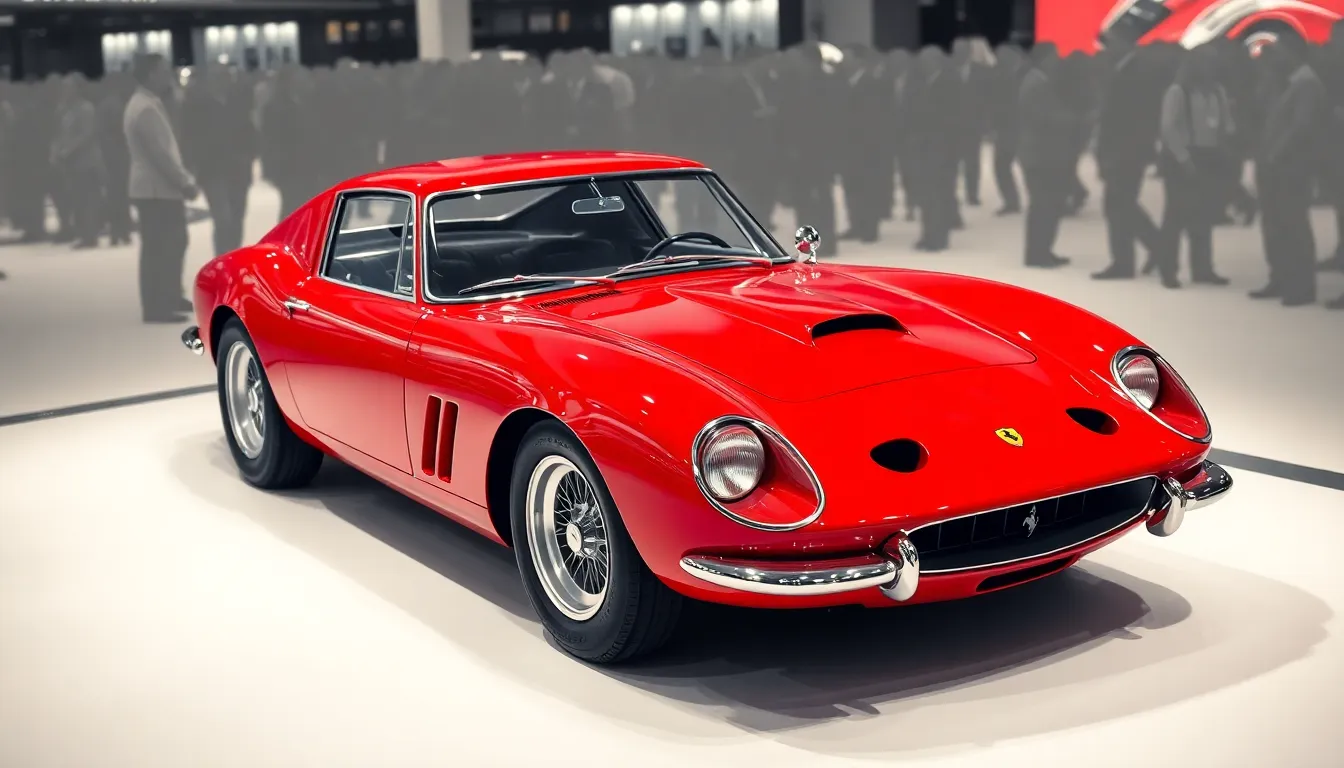We’ve all dreamed of owning something truly extraordinary – a machine that turns heads and sparks conversations wherever it goes. Rare cars represent the pinnacle of automotive exclusivity, where engineering brilliance meets limited production numbers to create rolling pieces of history.
From forgotten prototypes that never saw mass production to ultra-limited supercars with price tags that rival luxury homes, the industry of rare automobiles offers endless fascination. These aren’t just vehicles; they’re investments, status symbols, and mechanical masterpieces that appreciate in value while delivering unmatched driving experiences.
Whether you’re a seasoned collector hunting for your next acquisition or an automotive enthusiast curious about what makes certain cars so coveted, we’ll explore the most sought-after rarities on the market. We’ll uncover the stories behind these automotive gems and reveal what drives their astronomical values in today’s collector car market.
Ferrari 250 GTO: The Holy Grail of Rare Cars
Among the rarest automotive treasures in existence, the Ferrari 250 GTO stands as the ultimate collector’s dream car.
Limited Production Numbers and Exclusivity
Ferrari produced only 36 examples of the legendary 250 GTO between 1962 and 1964. The Italian manufacturer’s strict selection process meant only established Ferrari customers and professional racing drivers could purchase these extraordinary machines. We find that Enzo Ferrari personally approved each buyer, creating an exclusive club that remains virtually unchanged today.
Each 250 GTO features a hand-built 3.0-liter V12 engine producing 300 horsepower. The bodywork combines aerodynamic efficiency with stunning Italian design, making every example a unique piece of automotive art. Serial numbers ranging from 3223GT to 5575GT identify each car, with enthusiasts tracking the location and ownership history of every surviving example.
The rarity extends beyond production numbers to current availability. Private collectors own nearly all 36 examples, with many vehicles remaining in the same families for decades. Museum displays occasionally feature these cars, but public appearances are extraordinary events that draw thousands of automotive enthusiasts worldwide.
Record-Breaking Auction Prices
The Ferrari 250 GTO holds multiple industry records for the highest prices ever paid for collector cars. A 1962 example sold for $48.4 million at RM Sotheby’s in 2018, establishing the current public auction record. Private sales have reportedly reached even higher figures, with some transactions exceeding $70 million according to industry sources.
| Year | Sale Price | Auction House | Chassis Number |
|---|---|---|---|
| 2018 | $48.4 million | RM Sotheby’s | 3413GT |
| 2014 | $38.1 million | Bonhams | 3851GT |
| 2013 | $52 million | Private Sale | 5111GT |
Market appreciation for these vehicles has consistently outperformed traditional investments. Values have increased by approximately 500% over the past two decades, making the 250 GTO one of the most successful alternative assets in history. Insurance companies now require specialized coverage policies, with annual premiums often exceeding $100,000 for a single vehicle.
The scarcity factor drives prices higher each year as wealthy collectors compete for ownership opportunities. Financial experts consider 250 GTOs as blue-chip investments that combine passion with remarkable returns, creating demand that far exceeds the limited supply.
Racing Heritage and Performance Legacy
Ferrari designed the 250 GTO specifically for international GT racing competition, achieving remarkable success on tracks worldwide. The model dominated the Industry Sportscar Championship from 1962 to 1964, capturing three consecutive GT class titles. We see evidence of this racing DNA in every aspect of the car’s construction, from its lightweight steel chassis to its competition-tuned suspension system.
Notable racing victories include overall wins at the Tour de France Automobile and class victories at Le Mans, Sebring, and the Targa Florio. Professional drivers like Stirling Moss, Phil Hill, and Lorenzo Bandini piloted these machines to victory, establishing legendary reputations that enhance collector desirability today.
The aerodynamic bodywork resulted from extensive wind tunnel testing and real-industry racing experience. Sergio Scaglietti’s craftsmen shaped each aluminum panel by hand, creating the distinctive long-nose design that became synonymous with Ferrari’s racing excellence. Track-proven components include Borrani wire wheels, racing-spec brakes, and a close-ratio gearbox optimized for circuit competition.
Modern vintage racing events showcase these cars’ continued performance capabilities. Owners regularly participate in historic races at Laguna Seca, Goodwood, and Spa-Francorchamps, demonstrating that these million-dollar machines remain formidable competitors decades after their initial victories.
Bugatti Type 57 Atlantic: Art Deco Automotive Masterpiece
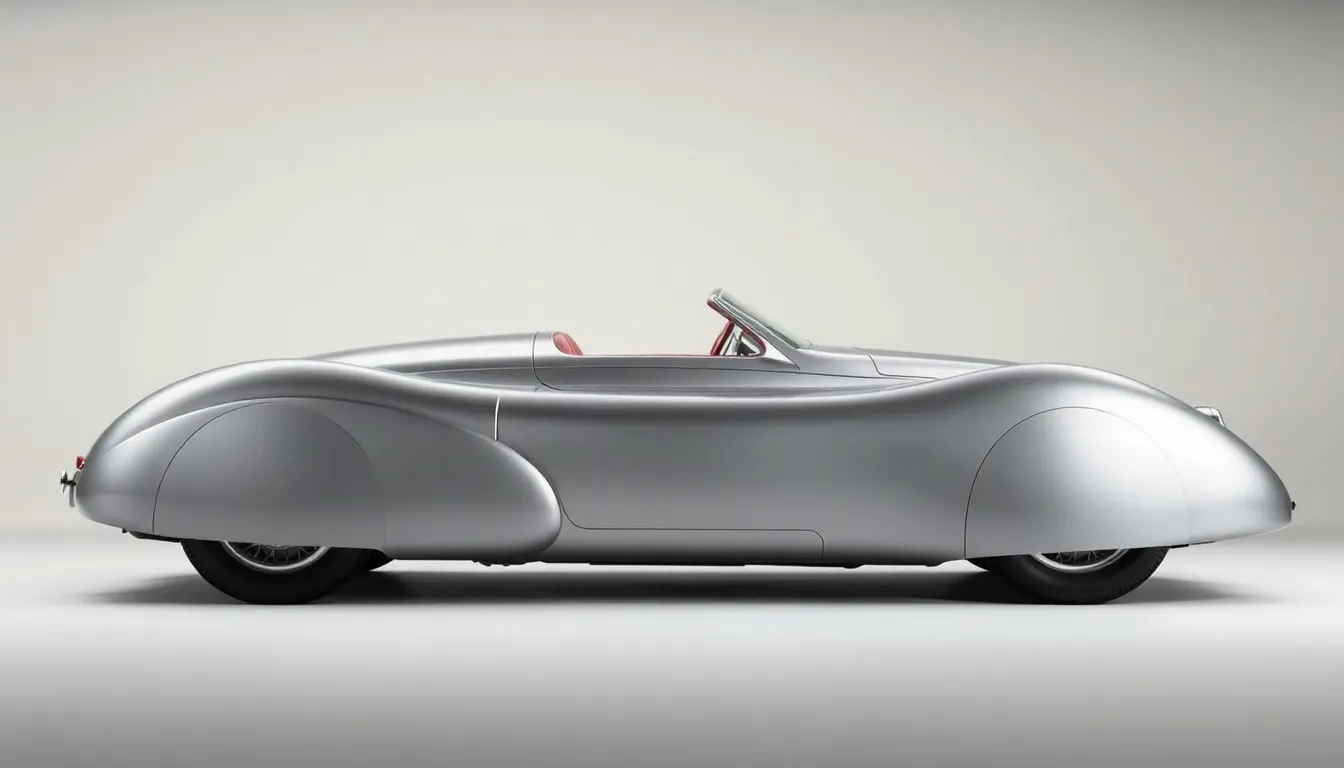
The Bugatti Type 57 Atlantic stands as one of the most revolutionary automotive designs of the 1930s, representing the pinnacle of Art Deco styling in automobile manufacturing. We’re examining a car that transcended traditional automotive boundaries to become a rolling sculpture.
Distinctive Riveted Body Design
Riveted aluminum construction defines the Type 57 Atlantic’s revolutionary appearance, creating a distinctive seam that runs down the center of the car’s body from nose to tail. We observe how Jean Bugatti’s innovative approach eliminated traditional welding techniques, instead utilizing rows of exposed rivets that became the car’s signature design element.
Aircraft manufacturing techniques influenced the Atlantic’s construction methods, with Bugatti employing lightweight aluminum sheeting similar to aviation industry practices. The riveted seam wasn’t merely decorative but served a functional purpose, allowing the two halves of the body to be joined without compromising structural integrity.
Streamlined bodywork showcases dramatic curves and flowing lines that epitomize Art Deco automotive design principles. We find the Atlantic’s silhouette unmistakable, with its teardrop shaped cabin and elongated hood creating an aesthetic that influenced automotive design for decades.
Only Four Units Ever Produced
Production limitations make the Type 57 Atlantic one of the rarest automobiles ever manufactured, with Bugatti completing just four examples between 1936 and 1938. We know that this extreme scarcity places the Atlantic among the most exclusive cars in automotive history, surpassing even the Ferrari 250 GTO in rarity.
Three surviving examples represent the complete known inventory of Type 57 Atlantics, with one car famously disappearing during Industry War II and never recovered. Each remaining vehicle commands astronomical values at auction, with recent sales exceeding $30 million.
Individual chassis numbers tell unique stories, including chassis 57374 owned by fashion designer Ralph Lauren and chassis 57473 that set auction records. We track these exact vehicles through their ownership histories, with each car representing a important chapter in automotive collecting.
Jean Bugatti’s Personal Vision
Artistic expression drove Jean Bugatti’s design philosophy for the Atlantic, blending his background in sculpture with automotive engineering expertise. We understand that Jean viewed the Atlantic as his masterpiece, incorporating elements from contemporary art movements into functional automotive design.
Personal involvement characterized every aspect of Atlantic production, with Jean Bugatti overseeing each detail from initial sketches to final assembly. His vision extended beyond mere transportation, creating what many consider the most beautiful automobile ever produced.
Family legacy influenced the Atlantic’s development, as Jean sought to establish his own design identity within the renowned Bugatti marque. We recognize how the Atlantic represented Jean’s evolution from his father Ettore’s engineering focused approach toward a more artistic automotive philosophy.
McLaren F1: Engineering Excellence Redefined

Moving from the artistic masterpieces of Ferrari and Bugatti, we encounter a technological tour de force that redefined automotive engineering. McLaren’s F1 represents the pinnacle of 1990s supercar development, combining groundbreaking materials and revolutionary design concepts.
Revolutionary Carbon Fiber Construction
McLaren pioneered the use of carbon fiber monocoque construction in road cars with the F1’s development from 1988 to 1998. We see how Gordon Murray’s team created the first production car to feature a full carbon fiber chassis, weighing just 220 pounds compared to traditional steel frames that typically weigh over 500 pounds. The bodywork consists of lightweight carbon fiber panels that provide exceptional strength while maintaining structural integrity during high speed driving.
Manufacturing techniques borrowed from McLaren’s Formula 1 experience allowed engineers to create complex curved surfaces that would be impossible with conventional materials. Each F1 required approximately 3,000 hours of hand layup work to complete the carbon fiber components, contributing to the car’s $815,000 original price tag. McLaren produced only 106 total units across all variants, making the F1 significantly rarer than many contemporary supercars.
Central Driving Position Innovation
Positioning the driver’s seat in the center of the cockpit revolutionized supercar ergonomics and created an unparalleled driving experience. We observe how this unique three seat configuration places two passenger seats flanking the central driver position, providing optimal weight distribution and visibility. The design eliminates the compromise inherent in left or right hand drive layouts, creating perfect symmetry for racing applications.
McLaren’s central seating arrangement offers drivers an unobstructed view of the road ahead, with no A pillar interference affecting visibility during cornering. This configuration became the inspiration for later supercars including the Gordon Murray designed T.50, though few manufacturers have attempted to replicate the complex packaging requirements. The central position creates an almost fighter jet like experience, with all controls positioned within easy reach of the driver.
BMW V12 Engine Performance
BMW Motorsport developed the S70/2 naturally aspirated V12 engine specifically for the McLaren F1, producing 627 horsepower at 7,400 rpm. We recognize this powerplant as one of the most advanced engines of its era, featuring individual throttle bodies for each cylinder and a dry sump lubrication system derived from racing applications. The 6.1 liter displacement generates 479 lb-ft of torque, enabling acceleration from 0 to 60 mph in just 3.2 seconds.
Peak performance capabilities include a top speed of 240.1 mph, achieved during testing at Volkswagen’s Ehra Lessien facility in Germany. Gold foil lines the engine bay to reflect heat away from critical components, while the exhaust system produces one of the most distinctive sounds in automotive history. McLaren’s partnership with BMW resulted in an engine that remains naturally aspirated, contrasting sharply with today’s turbocharged supercars and maintaining pure throttle response throughout the rev range.
Lamborghini Veneno: Modern Rarity with Extreme Styling

We’re witnessing automotive extremism at its finest with the Lamborghini Veneno, a hypercar that pushes design boundaries while maintaining unprecedented exclusivity. This angular masterpiece represents Lamborghini’s boldest interpretation of modern supercar aesthetics.
Aggressive Aerodynamic Design
Radical aerodynamic elements define every surface of the Veneno’s carbon fiber bodywork, creating a spacecraft-like appearance that commands attention. Sharp angular lines and dramatic air intakes work together to channel airflow efficiently while generating substantial downforce at high speeds. Massive rear wing structures and front splitter assemblies create an aggressive stance that’s purely functional, with each component serving a exact aerodynamic purpose.
Distinctive Y-shaped design elements throughout the vehicle pay homage to Lamborghini’s signature styling cues while introducing futuristic interpretations. These geometric patterns appear in the headlight configuration, side air vents, and rear diffuser sections, creating visual continuity across the entire design. Carbon fiber construction allows for intricate detailing that would be impossible with traditional materials, enabling designers to create complex shapes that optimize both form and function.
Limited Edition Production Run
Lamborghini restricted Veneno production to just 14 total units worldwide, making it one of the most exclusive modern supercars ever created. Four coupes were manufactured for public sale, while nine roadster versions followed in subsequent years, with one additional prototype completing the production run. Each vehicle was hand-assembled at Lamborghini’s Sant’Agata Bolognese facility using the finest materials and craftsmanship techniques.
Buyers underwent strict selection processes similar to those employed for other ultra-rare vehicles, with Lamborghini carefully choosing owners based on their collecting history and brand loyalty. Serial numbers were individually assigned to each Veneno, creating permanent documentation of authenticity and provenance. Manufacturing timelines extended over several months per vehicle due to the complex carbon fiber construction and meticulous attention to detail required for each component.
Astronomical Market Value
Current market valuations for Veneno examples exceed $8 million, representing important appreciation from the original $4.5 million purchase price established in 2013. Auction records show consistent upward price trends, with pristine examples commanding premium valuations due to their remarkable rarity and condition. Private sales often occur above publicly reported figures, as collectors compete intensely for these exceptional machines.
| Production Year | Units Produced | Original MSRP | Current Market Value |
|---|---|---|---|
| 2013-2014 | 4 Coupes | $4.5M | $8M+ |
| 2014-2015 | 9 Roadsters | $4.9M | $9M+ |
Investment potential remains extremely strong given the limited supply and increasing demand from global collectors seeking modern automotive rarities. Veneno ownership provides entry into an exclusive club of hypercar enthusiasts who appreciate cutting-edge design and engineering excellence. Market analysts predict continued value growth as these vehicles age and become even more historically important within Lamborghini’s legendary lineup.
Shelby Cobra Daytona Coupe: American Racing Legend

The Shelby Cobra Daytona Coupe stands as America’s answer to European racing dominance, representing a pivotal moment when American automotive engineering conquered the industry’s most prestigious racing circuits.
Le Mans Championship Victory
Victory at Le Mans in 1964 marked the first time an American manufacturer claimed the Industry Sports Car Championship, ending Ferrari’s stranglehold on international GT racing. We witnessed Carroll Shelby’s team secure this historic triumph with the Daytona Coupe’s superior aerodynamics and powerful Ford 289 V8 engine producing 385 horsepower.
Dan Gurney and Bob Bondurant piloted the winning Coupe to speeds exceeding 180 mph on the Mulsanne Straight, demonstrating the car’s exceptional high speed stability. Racing legend Ken Miles also contributed to the championship campaign, achieving multiple podium finishes throughout the 1964 season. Only six original Daytona Coupes were ever built, making each surviving example incredibly valuable to collectors.
Current auction records show these championship winning cars command prices between $7 million and $15 million, reflecting their significance in American motorsport history. Modern vintage racing events still feature these legendary machines, where they continue to compete against period Ferraris and Porsches with remarkable success.
Aerodynamic Breakthrough Design
Breakthrough aerodynamic principles transformed the original Cobra roadster into a closed coupe capable of sustained high speed racing. We recognize Peter Brock’s revolutionary design work, which reduced drag coefficient from 0.46 to 0.31, making the Daytona Coupe significantly more efficient than its open top predecessor.
Wind tunnel testing revealed the coupe’s distinctive fastback profile generated 40% less drag than the roadster version, directly translating to higher top speeds and improved fuel economy during endurance racing. Streamlined bodywork incorporated aircraft inspired design elements, including carefully sculpted air intakes and a distinctive rear window angle optimized for airflow management.
Carbon fiber wasn’t available in 1964, so engineers used lightweight fiberglass construction combined with aluminum components to achieve optimal weight distribution. Racing development focused on balancing downforce with minimal drag, creating a car that remained stable at racing speeds while maximizing straight line performance.
Carroll Shelby’s Racing Philosophy
Philosophy behind the Daytona Coupe centered on Carroll Shelby’s belief that American muscle could outperform European sophistication through superior engineering and relentless testing. We understand Shelby’s approach combined Ford’s powerful V8 engines with British chassis expertise from AC Cars, creating a uniquely American interpretation of the sports car formula.
Strategic thinking led Shelby to focus on aerodynamic efficiency rather than just raw power, recognizing that endurance racing success required cars capable of sustained high speeds over extended periods. Development testing occurred at tracks like Riverside and Laguna Seca, where Shelby’s team refined suspension settings and aerodynamic packages for optimal performance.
Manufacturing precision became paramount, with each Daytona Coupe hand built to exact specifications and thoroughly tested before delivery to racing teams. Shelby’s racing program emphasized driver development alongside car development, creating a comprehensive approach that prepared both machine and pilot for championship competition.
Legacy continues today through continuation cars and exact replicas, though original examples remain among the most coveted American racing automobiles ever produced.
Porsche 917K: Le Mans Domination Machine

Transitioning from individual supercars to purpose-built racing machines, we encounter the Porsche 917K, a prototype that revolutionized endurance racing in the early 1970s. This legendary race car transformed Porsche from a sports car manufacturer into a Le Mans powerhouse through its innovative engineering and distinctive appearance.
Prototype Racing Technology
Revolutionary aerodynamics defined the 917K’s dominance at Le Mans between 1970 and 1971. Engineers at Porsche developed a lightweight magnesium space frame chassis weighing just 85 pounds, creating the foundation for unprecedented speed and handling. The flat-twelve engine produced 630 horsepower from its 5.0-liter configuration, enabling the 917K to reach speeds exceeding 240 mph on the Mulsanne Straight.
Wind tunnel testing played a crucial role in developing the car’s aerodynamic package. Porsche’s “K” designation stood for “Kurzheck” (short tail), indicating the revised bodywork that improved high-speed stability compared to earlier long-tail versions. Active cooling systems regulated the powerful engine’s temperature during grueling 24-hour races.
Carbon fiber construction wasn’t available in 1970, so Porsche utilized fiberglass bodywork over the magnesium frame to minimize weight. Total curb weight reached just 1,800 pounds, creating an extraordinary power-to-weight ratio that dominated competitors. Racing versions featured massive rear wings and front splitters that generated important downforce at racing speeds.
Steve McQueen Movie Fame
Hollywood immortalized the Porsche 917K through Steve McQueen’s 1971 film “Le Mans,” bringing prototype racing to mainstream audiences worldwide. McQueen’s production company purchased several 917K chassis for filming, including chassis 917-022 that became the hero car throughout the movie. Real Le Mans footage combined with staged racing sequences created an authentic portrayal of endurance racing’s brutal nature.
Filming took place during the actual 1970 Le Mans race, with McQueen’s team capturing genuine racing action alongside fictional storylines. The production budget exceeded $7.5 million, making it one of the most expensive racing films ever produced at that time. McQueen performed many driving sequences himself, showcasing the 917K’s incredible performance capabilities on camera.
Behind the scenes drama included real crashes and mechanical failures that added authenticity to the final film. The movie featured actual racing drivers like Derek Bell and David Piper, lending credibility to the racing sequences. Original 917K chassis used in filming now command premium prices at auction, with McQueen provenance adding important value to their rarity.
Gulf Oil Livery Recognition
Iconic orange and powder blue Gulf Oil colors transformed the 917K into one of motorsport’s most recognizable liveries. The distinctive color scheme appeared on the factory-supported John Wyer Automotive Engineering team cars that secured Le Mans victories in 1970 and 1971. Gulf’s sponsorship deal with Porsche created a marketing partnership that continues to influence racing aesthetics today.
Professional racing teams adopted the Gulf livery across multiple 917K chassis, creating a consistent visual identity during competition. The color combination stood out against traditional racing colors, making Gulf-liveried 917Ks instantly identifiable to spectators and television audiences. Photography and film footage from the era cemented these colors as synonymous with Porsche’s Le Mans success.
Modern Porsche models still feature Gulf-inspired color schemes as special editions, demonstrating the livery’s enduring appeal among collectors and enthusiasts. Original Gulf-liveried 917K examples command auction prices between $14 million and $17 million, reflecting their historical significance and visual impact. Reproduction Gulf liveries appear on continuation cars and race replicas, but authentic examples remain among the most valuable prototype race cars ever produced.
Mercedes-Benz 300SL Gullwing: Iconic Door Design Pioneer
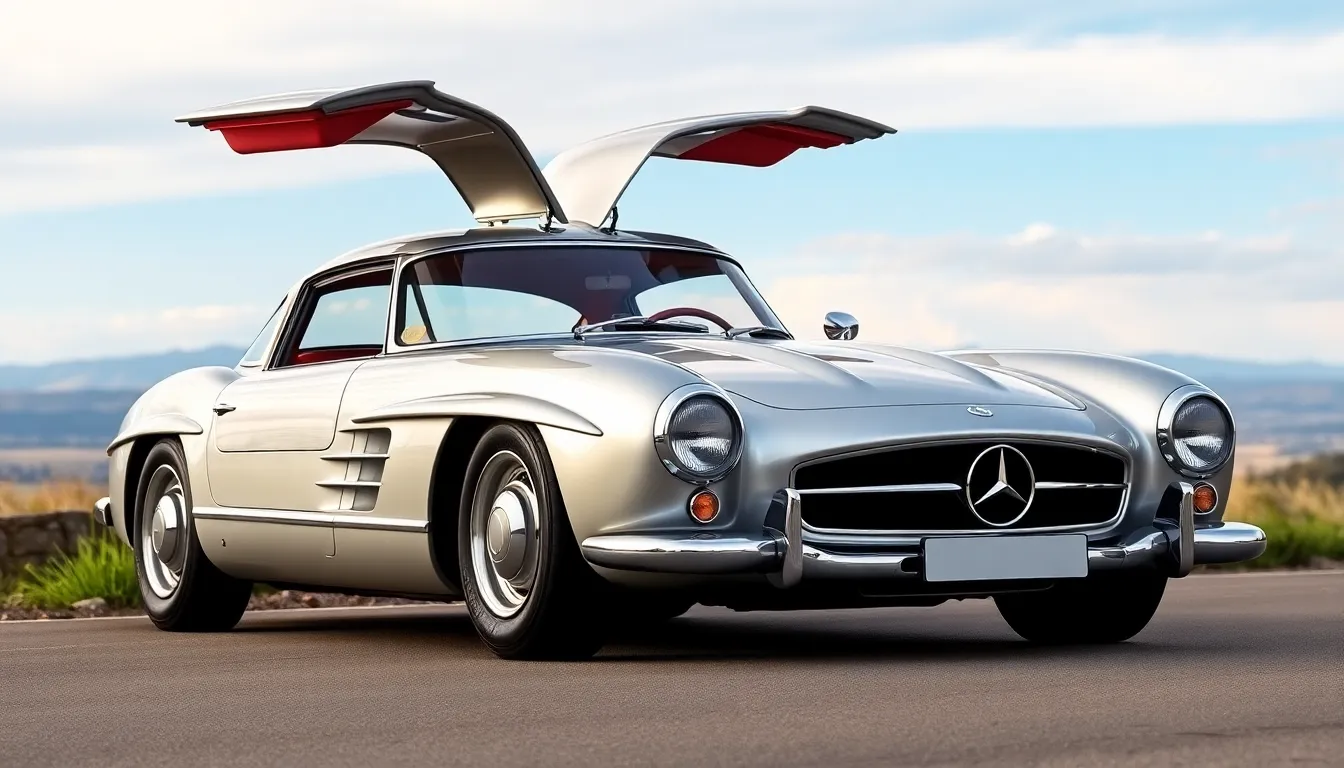
We encounter another legendary rare automobile that revolutionized both design and engineering: the Mercedes-Benz 300SL Gullwing. Production limited to just 1,400 coupes between 1954 and 1957 makes this vehicle one of the most coveted post-war sports cars.
Revolutionary Fuel Injection System
Direct fuel injection technology made its production car debut in the 300SL, establishing Mercedes-Benz as a pioneer in advanced engine systems. Engineers at Mercedes developed the Bosch mechanical fuel injection system specifically for the 300SL’s 3.0-liter inline-six engine, delivering 215 horsepower and remarkable reliability.
Precision fuel metering allowed the 300SL to achieve superior performance compared to carburetor-equipped competitors of the era. Each cylinder received precisely measured fuel through individual injection nozzles, resulting in improved throttle response and fuel efficiency. This technological advancement became standard in modern automotive engineering decades later.
Racing-proven reliability demonstrated the fuel injection system’s effectiveness under extreme conditions. Mercedes tested this technology extensively during the car’s development, ensuring consistent performance across varying altitudes and temperatures. The system’s durability contributed significantly to the 300SL’s reputation as a dependable high-performance machine.
Racing-Derived Technology
Competition heritage flows directly from Mercedes-Benz’s successful W194 racing program into the 300SL’s production design. The original W194 race cars dominated events like the 1952 Carrera Panamericana and Le Mans 24 Hours, proving the effectiveness of the spaceframe chassis concept.
Tubular spaceframe construction required the iconic gullwing doors due to high door sills necessitated by the chassis design. Engineers couldn’t use conventional doors because the spaceframe’s structural members extended too high along the car’s sides. This engineering challenge created the 300SL’s most distinctive visual feature.
Lightweight aluminum bodywork covered the steel spaceframe, reducing overall weight while maintaining structural integrity. Mercedes craftsmen hand-formed each aluminum panel, creating subtle variations that make every 300SL unique. The combination of lightweight construction and aerodynamic efficiency enabled a top speed of 161 mph.
Competition-proven suspension featured coil springs and wishbones in front with a swing axle rear setup derived from racing experience. This suspension configuration provided excellent handling characteristics for the era while maintaining ride comfort suitable for grand touring. Professional race drivers praised the 300SL’s predictable handling behavior on both road and track.
Timeless Design Appeal
Sculptural elegance defines every line of the 300SL’s bodywork, from the distinctive grille with its three-pointed star to the flowing fender curves. Designer Friedrich Geiger created proportions that remain visually striking nearly seven decades after the car’s introduction. The long hood and compact cabin create classic sports car proportions that influenced automotive design for generations.
Gullwing doors continue to captivate enthusiasts and casual observers alike, making every 300SL entrance a memorable event. These upward-opening doors became synonymous with exotic automotive design, inspiring countless concept cars and limited production vehicles. The mechanism’s engineering complexity adds to the car’s mystique and exclusivity.
Interior craftsmanship showcases Mercedes-Benz’s attention to detail through hand-stitched leather, precise instrumentation, and quality materials throughout the cabin. Each 300SL interior reflects the era’s luxury standards while incorporating functional racing-inspired elements like the distinctive steering wheel and comprehensive gauge cluster.
Investment appreciation has made original 300SL Gullwings increasingly valuable, with pristine examples commanding prices between $1.2 million and $1.8 million at auction. Collectors recognize the 300SL’s historical significance as the first production car with fuel injection and its influence on subsequent Mercedes-Benz sports car development. Market values continue rising as fewer examples remain in original condition, solidifying the 300SL’s status among the most desirable rare automobiles ever produced.
Jaguar XKSS: Road-Going D-Type Legend
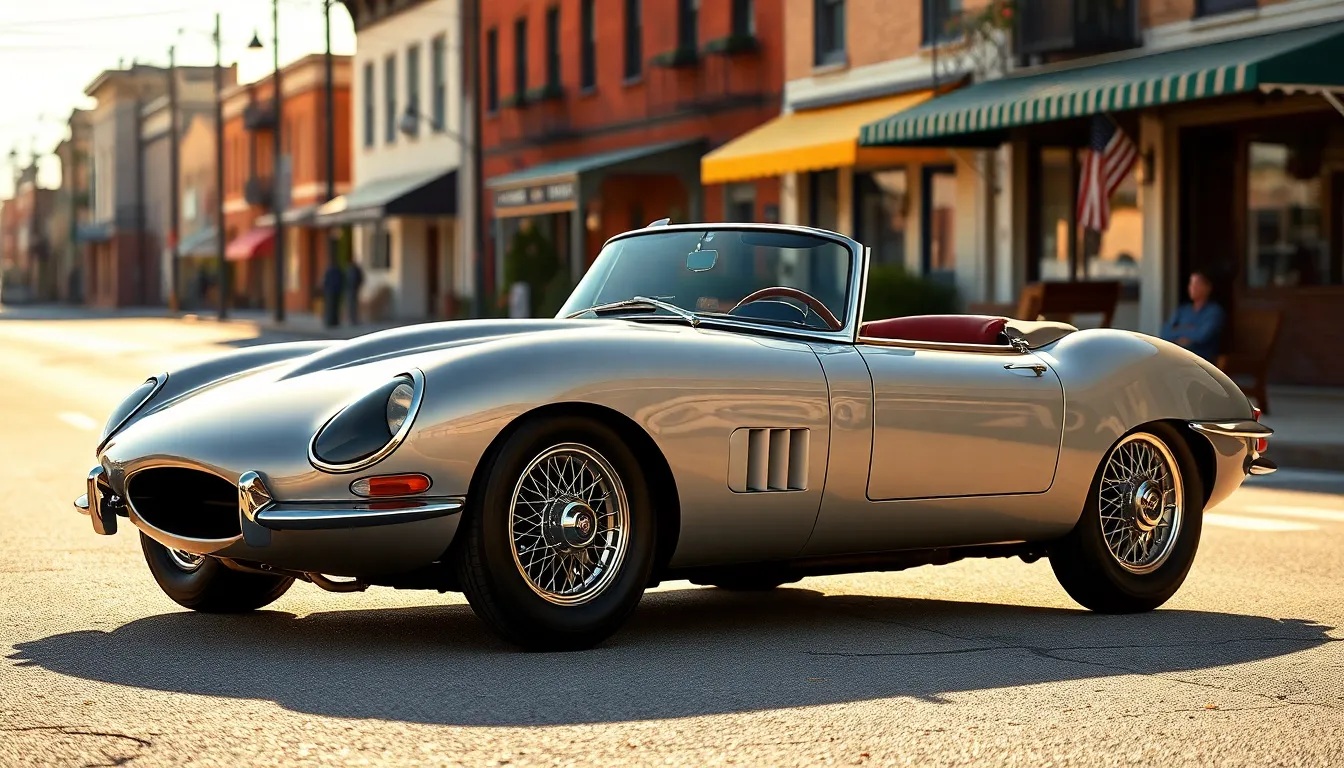
The Jaguar XKSS stands as one of the most tragic yet legendary stories in automotive history. Born from racing excellence, this British masterpiece represents what might have been one of the industry’s first supercars.
Factory Fire Tragedy Impact
Fire devastated Jaguar’s Browns Lane factory on February 12, 1957, destroying nine unfinished XKSS chassis and forever limiting production to just 16 units. Originally, Jaguar planned to produce 25 examples of this road-going D-Type variant, but the catastrophic blaze reduced availability by nearly 40%. Only seven XKSS models were completed before the fire, with the remaining nine chassis assembled afterward from salvaged components and spare parts.
Production economics became impossible after the fire, as Jaguar faced massive reconstruction costs and component shortages. The company’s focus shifted entirely to rebuilding manufacturing capabilities rather than continuing limited production runs. Insurance settlements couldn’t compensate for the irreplaceable hand-formed aluminum bodywork dies and specialized tooling that melted in the intense heat.
Rarity intensified dramatically following this industrial disaster, transforming the XKSS from a limited production vehicle into one of the industry’s scarcest automobiles. Today’s surviving examples command auction prices between $12 million and $15 million, with their value directly tied to this tragic production story.
Racing Pedigree Heritage
D-Type racing DNA flows through every component of the XKSS, as Jaguar engineers essentially removed the large tail fin and added minimal road equipment to create a street legal racer. Le Mans victories in 1955, 1956, and 1957 proved the D-Type’s racing superiority, with the same 3.4-liter XK inline six engine producing 250 horsepower in both configurations.
Monocoque construction techniques borrowed directly from aircraft manufacturing gave the XKSS exceptional rigidity while maintaining lightweight characteristics. The car’s dry weight of just 1,890 pounds delivered incredible power-to-weight ratios that modern supercars struggle to match. Racing heritage shows in every detail, from the competition-spec disc brakes to the aerodynamically optimized bodywork that achieved stability at speeds exceeding 140 mph.
Championship bloodlines extend beyond Le Mans success, as D-Type variants dominated international sports car racing throughout the 1950s. Private racing teams continued campaigning XKSS models in vintage events, where their competitive DNA remains evident decades after production ended.
Steve McQueen Ownership History
McQueen purchased his XKSS in 1958 for approximately $5,000, making it one of his most famous automotive acquisitions alongside his Highland Green Mustang. The Hollywood icon drove this particular example regularly around Los Angeles, treating it as a daily driver rather than a garage queen. Chassis XKD 538 became McQueen’s favorite weekend car, often seen at Malibu beaches and Beverly Hills social events throughout the early 1960s.
Ownership lasted nearly two decades, with McQueen keeping the XKSS until 1977 when financial pressures forced him to sell the car for $40,000. His mechanical appreciation for the Jaguar’s racing heritage aligned perfectly with his passion for motorcycles and high-performance automobiles. The actor’s hands-on approach to maintenance meant he understood every aspect of the car’s temperamental nature and incredible capabilities.
Celebrity provenance significantly enhanced the XKSS’s collectible status, as McQueen’s ownership story became inseparable from the car’s identity. When his example sold at auction in 2010, it achieved $2.31 million, demonstrating how Hollywood history can multiply automotive values exponentially.
Aston Martin DBR1: British Racing Excellence

The DBR1 stands as Britain’s most successful racing sports car, capturing both the Industry Sports Car Championship and prestigious endurance victories. We consider this rare machine the pinnacle of 1950s British motorsport engineering.
Le Mans and Tourist Trophy Victories
Dominating endurance racing became the DBR1’s defining achievement. Carroll Shelby and Roy Salvadori piloted chassis DBR1/1 to victory at the 1959 24 Hours of Le Mans, marking Aston Martin’s first and only outright win at the Circuit de la Sarthe. This triumph ended Ferrari’s stranglehold on endurance racing and established British engineering prowess on the industry stage.
Tourist Trophy success followed with remarkable consistency. Stirling Moss secured victory at the 1958 RAC Tourist Trophy at Goodwood, while the DBR1 claimed additional TT wins in 1959. These victories demonstrated the car’s versatility across different circuit configurations and racing conditions.
Industry Championship glory crowned the DBR1’s racing career. Aston Martin clinched the 1959 Industry Sports Car Championship for manufacturers, with the DBR1 earning crucial points at Nürburgring, Le Mans, and Tourist Trophy events. Only five DBR1s were ever built, making each victory even more important in motorsport history.
Stirling Moss Racing Connection
Legendary British driver Stirling Moss formed an inseparable bond with the DBR1. Moss piloted DBR1/4 to multiple victories, including the 1958 Nürburgring 1000km where he dominated German competition on home soil. His driving style perfectly complemented the car’s balanced handling characteristics and responsive nature.
Partnership excellence defined Moss’s DBR1 campaigns. Working alongside co-drivers like Jack Brabham and Tony Brooks, Moss extracted maximum performance from the DBR1’s 3.0-liter straight-six engine. The combination produced 250 horsepower and propelled the lightweight aluminum-bodied racer to speeds exceeding 180 mph.
Racing legacy continues through Moss’s testimonials. The racing icon consistently praised the DBR1’s predictable handling and mechanical reliability, calling it one of the finest sports racing cars he ever drove. Moss’s endorsement elevated the DBR1’s reputation among collectors and racing enthusiasts worldwide.
Elegant British Design Philosophy
Sophisticated aesthetics distinguished the DBR1 from continental rivals. Designer Frank Feeley crafted sleek bodywork that balanced aerodynamic efficiency with quintessentially British elegance. The DBR1’s graceful curves and purposeful stance created a timeless silhouette that remains beautiful decades later.
Engineering refinement characterized every DBR1 component. Aston Martin’s Tadek Marek developed the twin-cam straight-six engine with meticulous attention to detail, while the tubular space frame chassis provided exceptional rigidity. Each DBR1 received hand-finished aluminum bodywork that demonstrated British craftsmanship at its finest.
Auction values reflect the DBR1’s historical importance. DBR1/1, the Le Mans-winning chassis, sold for $22.6 million at RM Sotheby’s in 2017, establishing a record for British racing cars. The remaining four examples command similar valuations, with collectors recognizing their significance as symbols of British motorsport achievement and engineering excellence.
Ford GT40 MkIV: American Le Mans Warrior
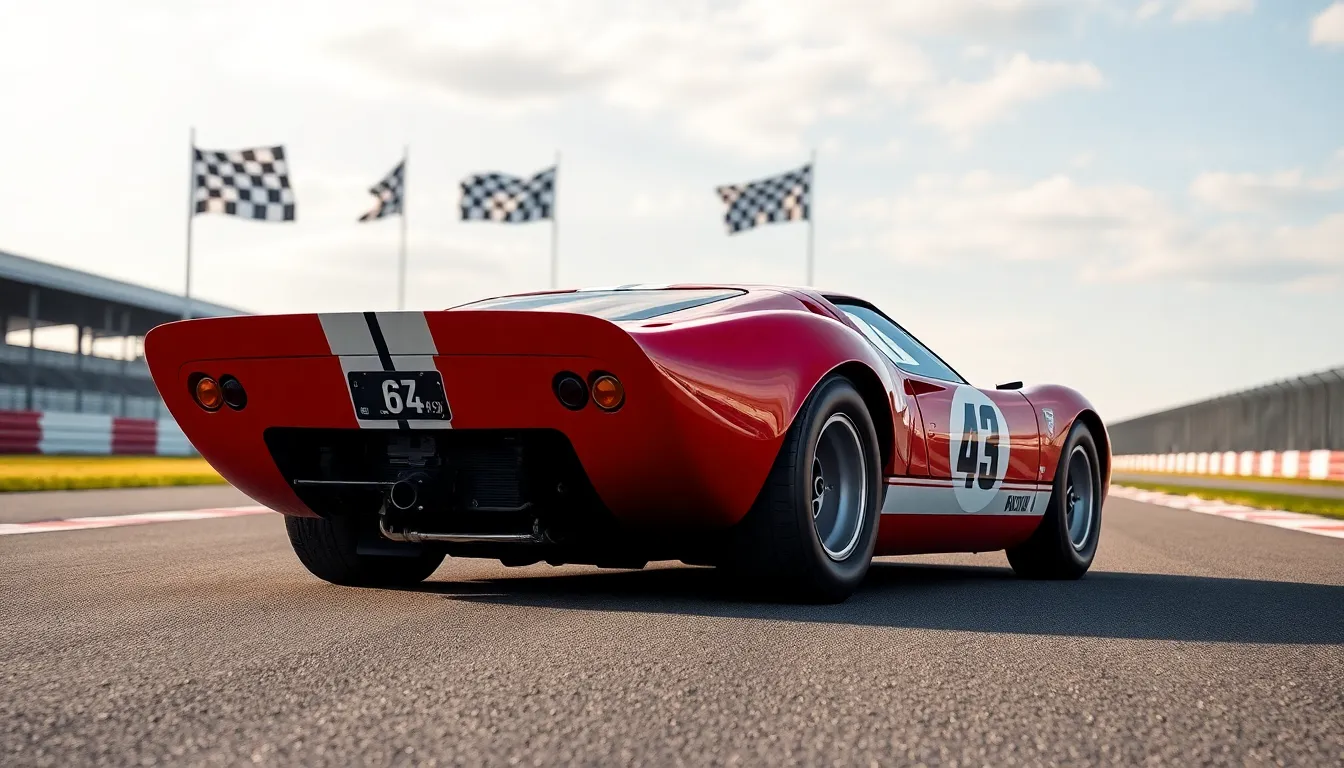
We encounter perhaps the most aggressive evolution of America’s Le Mans assault weapon in the GT40 MkIV. Ford’s determination to dominate endurance racing reached its peak with this ultimate iteration of their legendary prototype.
Ferrari-Beating Performance Legacy
Performance dominance defined the GT40 MkIV’s mission to end Ferrari’s European supremacy at Le Mans. Ford engineers developed a thunderous 7.0-liter V8 engine that produced 485 horsepower, delivering the raw American muscle needed to outrun Italy’s finest racing machines. The MkIV’s top speed exceeded 200 mph on the Mulsanne Straight, establishing new benchmarks for prototype racing velocity.
Racing pedigree distinguished this ultimate GT40 variant from its predecessors through sophisticated aerodynamic refinements. Ford’s competition department integrated advanced wind tunnel testing to optimize downforce and reduce drag coefficients. The distinctive high tail design created exceptional stability at racing speeds while maintaining the aggressive aesthetic that made GT40s instantly recognizable on international circuits.
Victory celebrations marked the MkIV’s immediate success in SCCA Can-Am racing before its Le Mans debut. Championship wins demonstrated Ford’s engineering excellence across multiple racing categories. Mario Andretti and other legendary drivers praised the MkIV’s superior handling characteristics and consistent performance delivery throughout extended racing sessions.
Advanced Lightweight Construction
Construction innovations set the GT40 MkIV apart through Ford’s adoption of cutting-edge materials and manufacturing techniques. Engineers utilized aluminum honeycomb panels bonded to lightweight steel frames, reducing overall weight while increasing structural rigidity. This advanced construction methodology preceded modern composite manufacturing by several decades.
Aerodynamic bodywork featured extensive use of fiberglass panels shaped through precision molds developed specifically for racing applications. The MkIV’s distinctive nose design incorporated functional air intakes that directed cooling air to critical engine components. Removable body sections allowed racing teams to perform rapid maintenance during endurance events.
Weight distribution achieved optimal balance through strategic placement of fuel tanks and mechanical components. Ford’s engineers positioned the driver closer to the centerline while maintaining excellent visibility and ergonomic control access. The result was a racing machine that weighed approximately 2,200 pounds, significantly lighter than competing European prototypes.
Manufacturing precision ensured each MkIV chassis met exact specifications for international racing homologation. Only nine complete MkIV units were ever produced, making surviving examples extraordinarily rare among American racing automobiles. Hand-built construction methods created unique characteristics in each individual chassis.
Historic Racing Achievements
Championships earned by the GT40 MkIV established Ford’s permanent place in endurance racing history through victories at prestigious international events. The 1967 24 Hours of Le Mans witnessed American drivers Dan Gurney and A.J. Foyt piloting chassis J-6 to overall victory, marking the second consecutive Ford triumph at motorsport’s most demanding test. Their winning margin exceeded Ferrari entries by multiple laps, demonstrating the MkIV’s superior reliability and speed.
Speed records fell throughout 1967 as MkIV entries dominated SCCA Can-Am series events across North American racing circuits. Mario Andretti secured multiple victories while establishing new lap records at legendary venues including Watkins Glen and Laguna Seca. The MkIV’s consistent performance attracted factory support from Ford’s Special Vehicle Operations division.
International recognition followed the MkIV’s success in Sports Car Industry Championship events throughout Europe and North America. Racing journalists praised Ford’s achievement in developing a prototype capable of matching European engineering excellence. The distinctive American roar of the 7.0-liter V8 became synonymous with victory celebrations at racing circuits worldwide.
Auction values for surviving GT40 MkIV examples reflect their historic significance, with chassis commanding prices between $9 million and $12 million at major collector car sales. Private collectors recognize these machines as representing America’s finest achievement in prototype racing development. Museums display MkIV examples as symbols of Ford’s engineering prowess during the golden age of endurance racing.
Conclusion
Rare cars represent the pinnacle of automotive achievement where artistry meets engineering excellence. These extraordinary machines transcend mere transportation to become cultural icons that capture our collective imagination and preserve automotive history.
We’ve witnessed how exclusivity drives value with production numbers often measured in dozens rather than thousands. From the Ferrari 250 GTO’s hand-selected ownership to the Bugatti Atlantic’s Art Deco mastery each vehicle tells a unique story of innovation and craftsmanship.
The investment potential of rare automobiles continues to outpace traditional assets making them increasingly attractive to collectors worldwide. Whether it’s a racing legend like the Porsche 917K or a design masterpiece like the Mercedes 300SL Gullwing these cars prove that true automotive artistry appreciates over time.
Our fascination with rare cars will only intensify as these mechanical treasures become increasingly scarce and their historical significance grows more profound.
Frequently Asked Questions
What makes the Ferrari 250 GTO so valuable and rare?
The Ferrari 250 GTO is extremely rare with only 36 units produced between 1962-1964. Each car was hand-built with a 3.0-liter V12 engine and unique design elements. Enzo Ferrari personally approved each owner through a strict selection process. Record auction prices include a 1962 model selling for $48.4 million in 2018, making it one of the most valuable cars ever sold.
How many Bugatti Type 57 Atlantic cars exist today?
Only four Bugatti Type 57 Atlantic cars were ever produced between 1936-1938, making it rarer than the Ferrari 250 GTO. These Art Deco masterpieces feature distinctive riveted aluminum construction influenced by aircraft manufacturing. Their astronomical auction values exceed $30 million, and they’re considered among the most beautiful automobiles ever created by Jean Bugatti’s artistic vision.
What made the McLaren F1 revolutionary in automotive engineering?
The McLaren F1 pioneered carbon fiber monocoque construction in the 1990s, significantly reducing weight while enhancing strength. Its unique central driving position revolutionized supercar ergonomics. The BMW-developed S70/2 V12 engine produced 627 horsepower, enabling a top speed of 240.1 mph. This combination of innovative design and engineering excellence redefined what supercars could achieve.
Why is the Lamborghini Veneno considered extremely exclusive?
The Lamborghini Veneno had only 14 units produced, making it one of the most exclusive modern supercars. Each vehicle was hand-assembled with a carbon fiber body featuring aggressive aerodynamic design. Buyers underwent strict selection based on collecting history. Current market valuations exceed $8 million, nearly doubling from its original $4.5 million price, showing strong investment potential.
What racing achievement made the Shelby Cobra Daytona Coupe legendary?
The Shelby Cobra Daytona Coupe achieved victory at Le Mans in 1964, ending Ferrari’s dominance in international GT racing. Only six original units were produced, featuring superior aerodynamics and a powerful Ford 289 V8 engine. This American racing achievement commands auction prices between $7-15 million, representing Carroll Shelby’s philosophy of combining American muscle with engineering excellence.
How did the Porsche 917K transform endurance racing?
The Porsche 917K revolutionized endurance racing in the early 1970s with its lightweight magnesium space frame chassis and flat-twelve engine producing 630 horsepower. Its “Kurzheck” aerodynamic design enabled speeds exceeding 240 mph at Le Mans. The iconic Gulf Oil livery and Steve McQueen’s “Le Mans” film brought mainstream attention, with original examples commanding $14-17 million at auction.
What innovation made the Mercedes-Benz 300SL Gullwing special?
The Mercedes-Benz 300SL Gullwing was the first production car with direct fuel injection, enhancing performance and reliability. Produced in only 1,400 units (1954-1957), it featured iconic gullwing doors, lightweight aluminum bodywork, and competition-proven suspension. Its timeless design and historical significance command auction prices from $1.2-1.8 million, making it highly sought after by collectors.
Why are Jaguar XKSS examples so valuable despite limited production?
Only 16 Jaguar XKSS units were completed due to a factory fire that destroyed nine unfinished chassis. Based on the D-Type racer, it offered exceptional performance characteristics. Steve McQueen’s ownership of one example significantly enhanced collectible status. This tragic production story and celebrity provenance drive auction prices between $12-15 million for surviving examples.
What makes the Aston Martin DBR1 Britain’s most successful racing sports car?
The Aston Martin DBR1, with only five units built, achieved Aston Martin’s first and only outright Le Mans victory in 1959. It also secured the 1959 Industry Sports Car Championship and multiple Tourist Trophy wins. Stirling Moss’s connection and praise for its handling added to its legend. The Le Mans-winning chassis sold for a record $22.6 million, reflecting its historical importance.
How did the Ford GT40 MkIV establish America’s Le Mans dominance?
The Ford GT40 MkIV featured a 7.0-liter V8 engine producing 485 horsepower, enabling speeds over 200 mph. Advanced aerodynamic refinements, aluminum honeycomb panels, and lightweight fiberglass bodywork set it apart. Its 1967 Le Mans victory established Ford’s endurance racing legacy over Ferrari. Surviving examples command auction prices between $9-12 million, reflecting their significance in automotive history.

